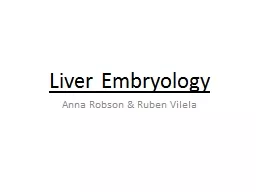

Primitive gut Made from the endoderm and visceral mesoderm Foregut Oropharyngeal membrane liver bud Coeliac A Oesophagus stomach liver biliary apparatus pancreas amp ½ duodenum ID: 777430
Download The PPT/PDF document "Liver Embryology Anna Robson & Ruben..." is the property of its rightful owner. Permission is granted to download and print the materials on this web site for personal, non-commercial use only, and to display it on your personal computer provided you do not modify the materials and that you retain all copyright notices contained in the materials. By downloading content from our website, you accept the terms of this agreement.
Slide1
Liver Embryology
Anna Robson & Ruben Vilela
Slide2Primitive gut
Made from the endoderm and visceral mesoderm
Foregut:
Oropharyngeal membrane
liver bud.
Coeliac A.
Oesophagus, stomach, liver, biliary apparatus, pancreas & ½ duodenum
Midgut
:
Liver bud 2/3rds transverse colon.
SMA.
Distal ½ of duodenum jejunum, ilium, caecum,
verifrom
appendix, ascending colon & right 2/3rds of TC
Hindgut:
2/3rds TC cloacal membrane.
IMA.
Left 1/3
rd
TC ,descending colon, sigmoid colon, rectum and anal canal
Slide3Liver bud
Hepatic diverticulum is a cellular expansion of the foregut that gives rise to the parenchyma of the liver
Slide4Liver cords
differentiate into
Hepatocytes
(liver parenchyma) and form the
lining of the biliary ducts.
Further growth of the liver bud allows the epithelial liver cords to intermingle with the umbilical and
vitelline
veins, forming the
Hepatic Sinusoids
.
Slide5Haematopoietic
cells,
Kupffer
cells
, and
connective tissue cells
are derived from mesoderm of the septum
transversum
.
Haematopoiesis
: important function of the liver at this stage since it acts as the “bone marrow” in the
production of white and red blood cells.
Slide6Mesenteries
Mesentery
= a fold of tissue that attaches organs to the body wall
Intraperitoneal =
Double layer of peritoneum that completely surrounds an organ
Retroperitoneal
= The organ is only covered by the peritoneum on its anterior side
Slide7Slide8Ventral mesentery
Occurs only in the foregut
Derived from the septum transversum
Foregut
has dorsal + ventral mesenteries
Midgut
and
hindgut
only have a dorsal mesentery
Slide9Ventral mesentery
The liver divides the ventral mesentery.
Falciform ligament
to the anterior abdominal wall
Free edge contains the
umbilical vein
the round ligament (ligamentum
teres
) after birth Lesser omentum to the ventral borders of the stomach and the duodenum Free edge contains hepatic artery, portal vein + bile duct
Slide10Bare area of liver
Bare area = the only area of the liver that is not covered by the ventral mesentery
Slide11Falciform ligament
Slide12Lesser omentum
Slide13Formation of the lesser omentum
Dorsal mesentery
Ventral mesentery
Liver
Slide14Liver bud
Entrance of Co. Bile duct
Liver
Extrahepatic
bile duct
Liver
Co. B. D
Co. B. D
Slide15Ligaments
Slide16The liver weight
is about
10%
of the total body weight. This is due to the presence of large numbers of sinusoids and involvement of the liver in
haematopoietic
function.
Hepatic cells start production of
Bile
. Since the gallbladder and cystic duct have developed, bile can enter the GI tract.
Slide17The
haematopoietic
function subsides during last 2 months of intrauterine life, which means that at
birth
the liver weighs about
5%
that of the body weight.
After birth:
-the
left umbilical vein
obliterates to form
ligamentum
Teres
hepatis
-
the
ductus
venosus
undergoes fibrosis, leaving a remnant designated
ligamentum
venosus
.
Slide18Key points
3
rd
week: endodermal growth from Foregut
Narrowing of the connection = Bile Duct
5
th
week: Ventral outgrowth will form the Cystic Duct and Gallbladder
Epithelial cords + umbilical &
vitelline
veins = Hepatic Sinusoids
6
th
week: active
haematopoietic
function
Ventral mesentery divided by liver into Lesser
Omentum
and
Falciform
Ligament
7/8
th
week: Rotation of the foregut shifts entrance of bile duct to a posterior position
12
th
week: production of bile and its entrance to the GI tract
Left umbilical vein
Ligamentum
teres
hepatis
Ductus
venosus
Ligamentum
Venosum
Slide19Questions??
Slide20C
O
N
G
R
A
T
U
L
A
TI
O
N
S
GUYS…
… you made it through!!!
Check out
“Awkward Yeti”
XD